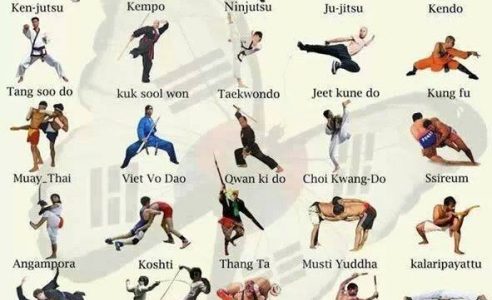Come Check Out The Captivating World Of Martial Arts, Where Ancient Customs Fulfill Modern Efficiency - A Journey Right Into Background And Viewpoint Awaits.
Come Check Out The Captivating World Of Martial Arts, Where Ancient Customs Fulfill Modern Efficiency - A Journey Right Into Background And Viewpoint Awaits.
Blog Article
https://coaching-kids-martial-art64208.ourcodeblog.com/31282684/discover-the-methods-which-martial-arts-can-significantly-boost-your-youngster-s-life-by-fostering-confidence-and-personality-development-from-a-young-age-unlock-their-complete-prospective-today -Barber Francis
Enter the ancient globe where martial arts were substantiated of necessity in varied areas. Societies crafted distinct fighting designs intertwined with historic contexts. Methods advanced over centuries with committed technique and cultural exchanges. Today, contemporary martial arts mix conventional elements for optimal efficiency. Philosophically, martial arts emphasize discipline, self-improvement, and harmony. Respect, humility, and equilibrium are foundational concepts guiding practitioners towards growth and strength. Explore https://www.courier-journal.com/story/opinion/2022/01/19/west-louisville-martial-artists-help-students-school-career-life-opinion/6529626001/ of this abundant background and ideology to uncover the profound influences shaping this long-lasting discipline.
Beginnings of Martial Arts
Martial arts originated in numerous areas around the world, progressing as useful combat systems to prevent risks. These ancient combating designs were established out of requirement, with each society crafting strategies fit to their special atmospheres and difficulties. From the grappling arts of Jujutsu in Japan to the striking techniques of Martial art in China, martial arts were deeply linked with the historical, social, and social material of their respective cultures.
In Japan, the samurai class refined martial arts like Kenjutsu, the art of the sword, which later on progressed into the much more popularized form of Kendo. At the same time, in Brazil, Capoeira became a blend of dancing and combat, created by enslaved Africans as a way to stand up to injustice. Each fighting style lugs with it an abundant history and ideology, mirroring the worths and beliefs of individuals who practiced them.
As you explore the origins of martial arts, you reveal a tapestry of human ingenuity, durability, and the unyielding spirit of warriors throughout time.
Advancement of Strategies
With centuries of method and improvement, fight techniques within numerous martial arts have undertaken an extensive evolution. From ancient designs like Kung Fu and Karate to much more modern-day disciplines such as Brazilian Jiu-Jitsu and Krav Maga, the advancement of methods has been driven by a mix of social impacts, sensible applications, and technological innovations.
One considerable aspect of this advancement is the cross-pollination of methods in between different martial arts. For example, techniques from standard Japanese Jiu-Jitsu were incorporated right into the production of Judo by Jigoro Kano in the late 19th century. This blending of designs has actually brought about the growth of hybrid martial arts like Mixed Martial Arts (MMA), which integrate aspects of striking, grappling, and entry techniques.
Additionally, the development of methods has been shaped by the raising focus on effectiveness and performance in battle. Specialists have actually constantly looked for to improve their methods with strenuous training, testing, and competitors, bring about the growth of extremely specialized and efficient combating designs. On the whole, the development of methods in martial arts shows the dynamic nature of battle and the ongoing quest for improvement and development.
Thoughtful Structures
Exploring the underlying philosophical concepts of martial arts provides understanding right into their core worths and guiding ideas. At the heart of numerous martial arts techniques is the idea of self-control itself. By educating your mind and body to work as one natural system, you grow technique that extends beyond the dojo or fitness center into day-to-day life. This self-control includes respect, humbleness, and self-control, forming not just your physical abilities but additionally your character.
An additional basic philosophical structure in martial arts is the idea of continual self-improvement. The journey of grasping a martial art is nonstop, with experts frequently aiming to better themselves, both literally and psychologically. This focus on growth fosters durability, determination, and a growth mindset that can be put on all elements of life.
Furthermore, martial arts highlight the significance of harmony and equilibrium. Strategies are designed to utilize a challenger's energy versus them, highlighting the principle of yielding and rerouting pressure rather than fulfilling it head-on. This ideology extends to social connections, promoting relaxed resolutions and mutual understanding. By welcoming these thoughtful foundations, martial artists not just boost their fight skills but likewise cultivate a way of living fixated individual development, regard, and harmony.
Final thought
Finally, the background and approach of martial arts offer an abundant tapestry of practice, technique, and self-improvement.
Take for example the story of Bruce Lee, that changed martial arts by blending different designs and ideologies to develop his very own one-of-a-kind form of Jeet Kune Do.
Through devotion and innovation, martial musicians continue to push boundaries and motivate others to reach their full capacity both in battle and in life.
